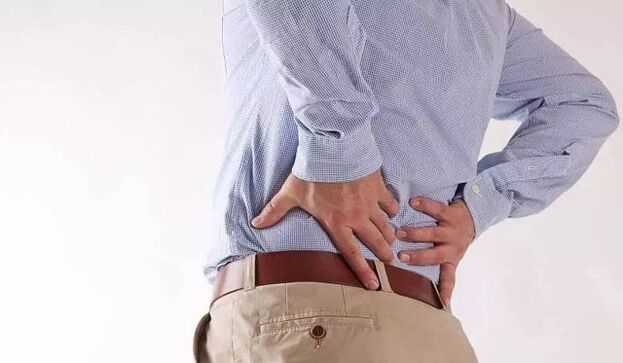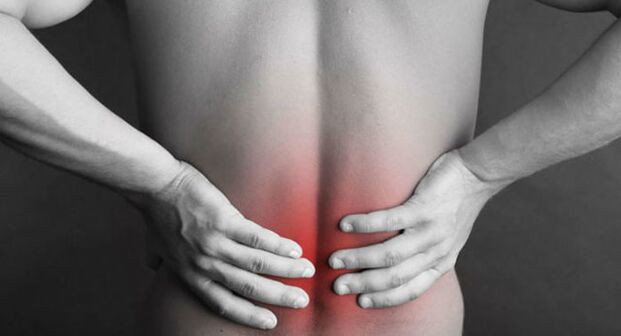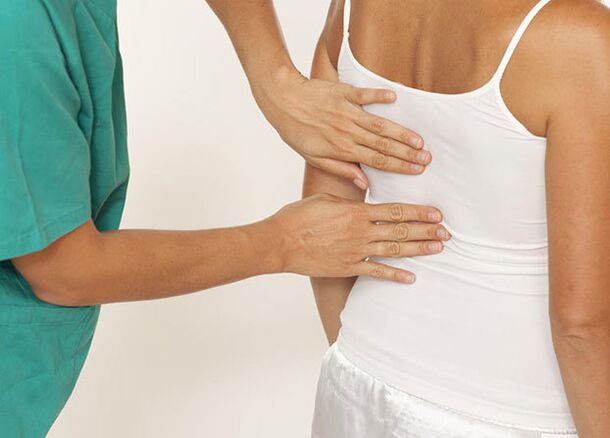About 80% of people over 55 experience manifestations of various back diseases and they should not ignore the faces of the younger age category. Therefore, among patients 25-45 years old, one of the most common diseases of lumbar spinal periosteum was also found. Even young people aged 16-25 are increasingly suffering from the symptoms and causes of this extremely unpleasant disease. The question is about whether it is possible to stop the trend of the general patient population and what each person does to avoid becoming a victim of this pathology?

symptom
Due to insufficient attention to the disease, it is difficult to diagnose and therefore difficult to treat. As a natural continuation of pathology, osteochondrosis began to develop. Its treatment is not always effective and when tightened or incorrect treatment occurs, there is a risk of disability. Another characteristic problem is the emergence of vertebral hernia, accompanied by unbearable pain. Every day, there are fewer and fewer opportunities to get rid of hernia.
Characteristic clinical symptoms help identify the disease early and avoid these pathetic consequences:
- Severe pain after going to bed at night;
- Pain, sharp body or lifting heavy things;
- The body becomes inactive;
- Signs of scoliosis;
- The dream becomes uneasy.
- Depression occurs;
- Noting frequent urine.
The independent assessment of these symptoms is incorrect because most of them share similarities with signs of other diseases in the spine or joints. Therefore, only rheumatologists or orthopedics have the ability to talk about the presence of osteocartilage in the lumbar area.
Classification
Differential diagnosis to correctly identify the disease, distinguish it from the same pathology and determine the treatment process, classification of the stages of this disease helps:
- Stage 1 - At this point, the structure of the cartilage has just begun to change. But now, the pathological process is affected by the nerve end root. Therefore, leg pain. At the same time, blood flow worsened and inflammation was born. The pain is acute or stupid, and occurs primarily only after strengthening the load on the back axis.
- The second stage begins with the destruction of the spinal annulus, while the cartilage is thinner and the vertebrae reduces distance from each other. The pain in the second stage is sharp and sometimes unreasonable. During this period, the spine's mobility across the entire axis will intensify, and the nerve clips are bound, which will create soft tissue pressure in the muscle corset;
- Stage 3 is characterized by strong compression of muscle fibers and nerve roots. Unbearable spasms and soreness appear, and burning characteristics appear. In the field of failure, a numb feeling. As the disease progresses extensively, signs of relief and paralysis appear.
- Stage 4 - Growth cycle of bone plants that have formed (tumors with bone structure). At this stage, changes in the degenerate nature are activated and arthritis and joints appear in the spine. The back becomes inactive, without proper treatment - completely immobile.
Diagnostic method
Because even the ideal knowledge of the clinic and the classification of lumbar osteochondrosis did not give him a complete understanding of the pathological processes he caused, a doctor is treating pathological processes in the spine, diseases of the musculoskeletal system, or diseases of the orthopedic doctor, must prescribe another diagnostic test: prescribe.
- X-rays in frontal and transverse projections - can identify deformation of the axis, formation of bone of the bone, anatomical abnormalities of the vertebrae;
- Magnetic resonance imaging determines the status of the entire back injury area, detecting damaged vertebrae fragments, cartilage and focal points of inflammation;
- Computed tomography gives the state of soft tissue, the vertebrae's bones, and the shell of the intervertebral disc are in principle of its integrity. and the blood circulation in the field of disease location.

At the same time, the patient underwent rheumatoid tests, general blood indicators, and content of biochemical components. The overall findings allow you to accurately determine the developmental stage of osteochondrosis in the lumbar area.
Symptoms and treatment of lumbar vertebrae
Among the common causes of back pain in the back, lumbar osteochondrosis, symptoms, and symptoms of treatment are characterized. The disease is the initial stage of osteochondria associated with the destruction process of the cartilage ring, intervertebral disc, its height changes, the formation of swelling and the clamping of nerve roots. Regardless of gender, social status and religion, young people and older people can face this disease. The long-term lack of symptoms of the disease can lead to a waste of valuable time and transition from one stage of the disease to a more severe developmental form. The main distinction of osteocartilage degeneration is the boundary area of dystrophic changes in vertebral tissue, which does not exceed articular cartilage.
Causes of the initial stage of osteochondrosis
Many external and internal factors determine the development of pathological status in the lumbar area of the axial bone. Lumbar osteochondral disease occurs due to certain risk factors. These include:
- The body ages after 50 years;
- Improper posture and abnormality of the anatomy of the axial bone, which determines the uneven load on the vertebrae;
- Lift weights with weak muscle frames;
- The patient's overall body and lower back are hypothermia;
- dysfunction of metabolic processes, work of endocrine organs, cardiovascular system;
- In the process of performing production responsibilities, housework, professional and amateur exercises, the burden on the spine is uneven;
- pathology of the musculoskeletal system that is innate or acquired;
- Hypotension, high frequency stress conditions;
- The patient is overweight;
- Deficiency of vitamins, minerals, trace elements in the patient's body is the cause of spinal health;
- Get high shoes, uncomfortable platform;
- Use high pillows and soft mattresses during rest and sleep.
The frequency of diagnosis of lumbar skeletal osteochondrosis depends on the number of risk factors present in the patient's life.
diagnosis
The determination of degenerative trophic lesions in one of the five vertebrae in the lumbar space of the axial skeleton provides diagnostic measures. They were prescribed by doctors. During consultation with experts who know how to treat lumbar osteochondrosis, the history of the disease, the timing and characteristics of the signs and the intensity and location of the pain sensation are being elucidated. The condition of muscle fibers in the injured area is determined by visual examination. Using the PALPATION method provides a chance for doctors to see pictures of vertebrae symmetry and how far they are. After other studies were obtained, a final diagnosis was established. These include:

- The X-rays were projected twice and provided the position of the vertebrae, the height of the disk, the edge plate and the seal for growth;
- Magnetic resonance imaging, a special research method, is used to determine the state of the vascular system and the annulus in the lesion of degenerative disease.
Objectives and methods of pathological treatment
The results of diagnostic measures are fundamental to the treatment of osteochondrosis in the lumbar bone bone, which pursues certain targets. These include:
- Reduced pain intensity caused by degenerative attenuation lesions of one or more vertebrae of the lumbar bone;
- normalization of metabolic processes in cartilage, their recovery and the risk of further destruction;
- Reduce the load on nerve fibers;
- Using massage, physical therapy procedures increase blood flow in the spinal tissue;
- Strengthen the muscle frame of the axial bone by regularly exercising the exercise therapy recommended by the teacher.
Treatment of lumbar chondrosis, its own characteristics of symptoms and treatment include taking and using drugs, traditional medical recipes, unconventional treatment methods, including Hirudytherapy. Effective supplements to address pathological problems are physical therapy, water, massage procedures, gymnastics and exercise, including special exercises. Drug therapy includes the use of anti-inflammatory nonsteroidal drugs, muscle relaxants, cartilage protectors, vitamin complexes with trace elements and minerals.
For very severe pain, novicaine or lidocaine blockage was prescribed and introduced into the affected location of the vertebrae by introducing the injection. For topical use, ointments, gels, face creams, patches with warming and anti-inflammatory effects are specified. Physical therapy includes treatments through electrophoresis, bimodal current, exposure to UV, manual, shock wave and reflectance procedures. In the absence of positive dynamics, the appearance of the hernia process was performed. In order to avoid the development of complications of the first symptom, treatment must be initiated immediately.
Lumbar vertebrae disease
Lumbar osteochondrosis is one of the most common forms of underlying diseases, and is actually osteochondrosis degeneration. Lumbar osteochondral disease, whose symptoms are similarly determined by men and women, are manifested in the form of pain concentrated in the ac bone area, reflected in its symptoms and lower limbs, usually determined by the patient as "climbing of the lumbar nerve".
Prominence of lumbar bone osteochondrosis
Furthermore, the most frequently developed proteins in our field of interest can lead to the emergence of lower back pain. Given its position and characteristics, the waist area itself is most affected by certain functional problems. That is to say, on the one hand, when considering this statement, we can distinguish our center of gravity directly and directly specify the waist department, which is precisely the important part of most load accounts. On the other hand, it can be noted that it can be noted that the significant magnitude of movement falls again on the waist area. Given this, the biggest trend to damage (and the standout of our interest) is to focus on the discs in the waist area. Furthermore, we cannot forget that, of course, changes occur in other fields, including changes occurring in the context of age-related regression processes.
Recall what the readers’ protrusion itself is. The connection between the intervertebral discs in the spine is provided by cartilage based on cartilage. The main components of the intervertebral disc are the dock nucleus and the fibrous annucleus through which fixation is provided within the frame of the spinal disc. The influence of certain factors and conditions poses the possibility of destroying the ring, which in turn occurs with a nuclear prominent background. Due to this process, the hernia develops. As for the protrusion, it has developed due to similar processes, but without the rupture of the ring - in this case it only causes thinning rather than breaking, as the core protrudes directly through the ring. In fact, this highlight is defined as a highlight.
As for the outstanding symptoms, it shows the following symptoms:
- Stiffness in the lower back;
- soreness in the waist area;
- Lower pain of chronic nature;
- lumbar radiation stone;
- Numbness, pain, fingers on the feet sting;
- Impaired urination function (in rare pathological cases under consideration).

Typically, conservative treatment is used for lumbar herniation. Meanwhile, significant development for prominent, often accompanied by severe symptoms, can resist treatment, in which case you can never do it again without surgical intervention.
treat
In most cases, the treatment of osteochondrosis is multi-component and its implementation is very complex. Generally, all treatment measures are reduced to the following points:
- Drug treatment;
- If necessary - surgical treatment;
- Diet;
- Medical Sports.
First, the aggravation of this disease requires patients to adhere to bed rest. The main advice in this section is a tough place to sleep. Extremely expressed in expression, the attack specifies the need for minimum motor load and early contact with relevant experts.






















